Trace Element and Sulfur Isotope Signatures of Volcanogenic Massive Sulfide (VMS) Mineralization: A Case Study from the Sunnhordland Area in SW Norway
Abstract
1. Introduction
2. Geological Setting
2.1. Regional Geology
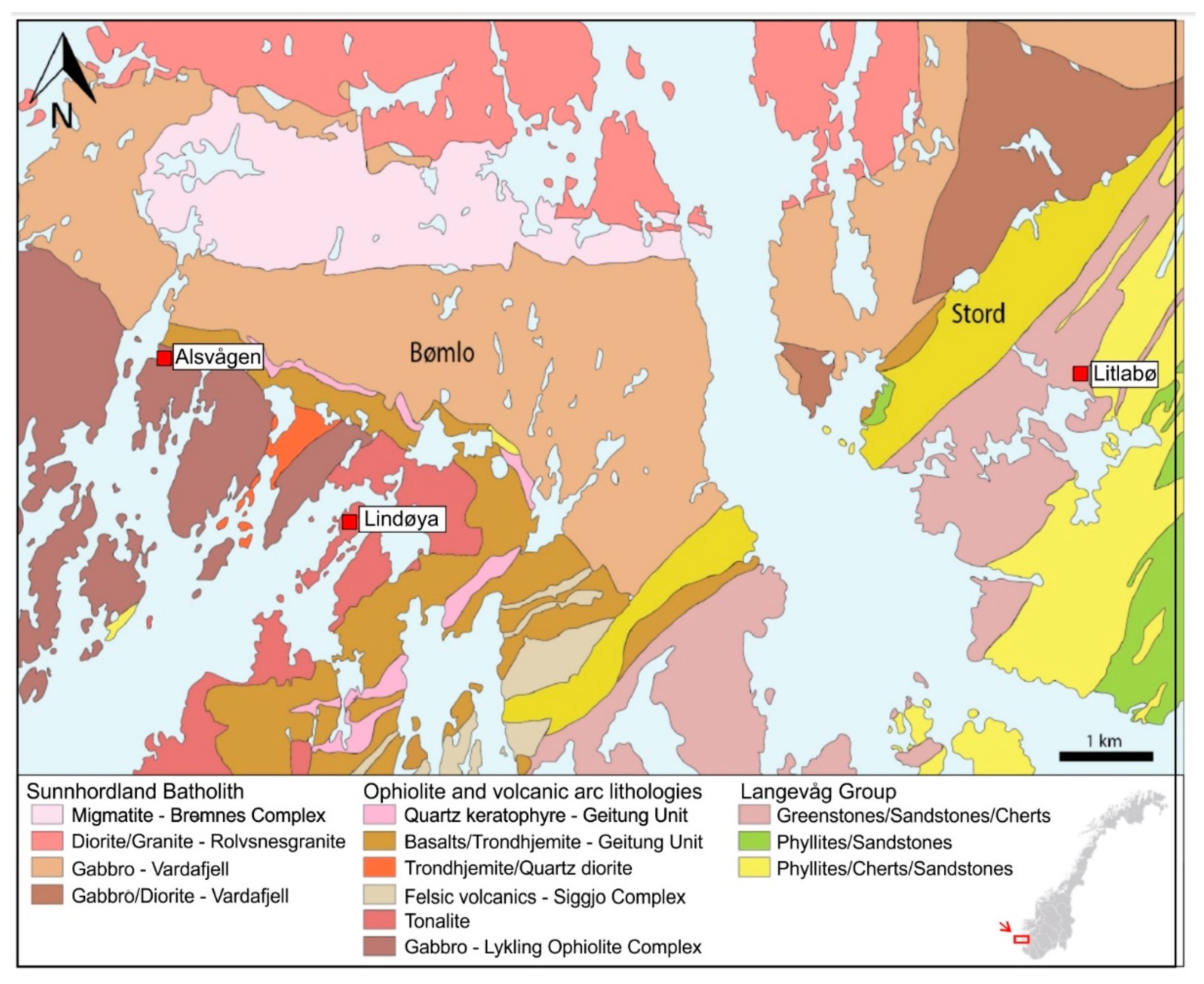
2.2. Geology of the Study Area
2.3. The VMS Mineralization in the Study Area
3. Samples and Methods
3.1. Samples
3.2. Analytical Methods
4. Results
4.1. Petrography of Host Rock and Ore Mineralization
4.1.1. The Alsvågen Gabbro-Hosted VMS Mineralization
4.1.2. The Lindøya Basalt-Hosted VMS Mineralization
4.1.3. The Litlabø Sediment-Hosted VMS Mineralization
4.2. Ore Grade Analysis
4.3. Trace Element Composition of Sulfide Minerals
4.4. Sulfur Isotopes
5. Discussion
6. Conclusions
Author Contributions
Funding
Data Availability Statement
Acknowledgments
Conflicts of Interest
Appendix A
| Sample | Mineral | S | Ti | V | Cr | Mn | Co | Ni | Cu | Zn | Ge | As | Se | Mo | Ag | Cd | In | Sb | Te | Au | Hg | Tl | Pb | Bi |
|---|---|---|---|---|---|---|---|---|---|---|---|---|---|---|---|---|---|---|---|---|---|---|---|---|
| (ppm) | ||||||||||||||||||||||||
| The Alsvågen gabbro-hosted VMS deposit | ||||||||||||||||||||||||
| 20ALS4F | Pyrrhotite | 425,296 | 3.69 | 0.017 | <0.195 | 0.88 | 2097.25 | 669.64 | 0.113 | <0.17 | 1.16 | 2.63 | 349.18 | 2.190 | 0.584 | 0.082 | 0.0063 | 0.133 | 0.964 | <0.001 | 0.320 | 0.009 | 1.236 | 0.149 |
| 20ALS4F | Pyrrhotite | 422,777 | 3.17 | 0.114 | 2.43 | 2.17 | 2276.11 | 674.51 | 1.671 | 0.93 | 0.15 | 3.15 | 335.35 | 1.679 | 0.730 | 0.101 | <0.0001 | 2.630 | 1.519 | <0.001 | 0.210 | 0.012 | 2.070 | 0.260 |
| 20ALS4F | Pyrrhotite | 417,103 | 3.82 | <0.007 | 1.58 | 2.64 | 2032.58 | 680.85 | 0.132 | 1.78 | <0.11 | 3.53 | 331.61 | 1.636 | 0.378 | 0.073 | <0.0010 | 0.340 | 0.730 | <0.001 | 0.410 | <0.00 | 0.268 | 0.046 |
| 20ALS4F | Pyrrhotite | 468,275 | 3.63 | <0.008 | 0.64 | 0.80 | 1662.66 | 648.78 | <0.115 | <0.23 | 0.29 | 2.02 | 389.42 | 1.910 | 0.154 | <0.025 | 0.0049 | 0.013 | 1.217 | <0.001 | 0.450 | <0.002 | 0.133 | 0.031 |
| 20ALS4F | Pyrrhotite | 442,520 | 4.60 | 0.049 | <0.225 | 0.85 | 1484.45 | 620.39 | <0.094 | <0.25 | <0.14 | 2.41 | 370.53 | 1.890 | 0.823 | <0.020 | <0.0016 | 0.780 | 1.630 | <0.001 | 0.260 | <0.001 | 0.981 | 0.300 |
| 20ALS4F | Pyrrhotite | 458,540 | 3.99 | <0.007 | 3.28 | 0.79 | 1617.11 | 657.11 | <0.102 | 0.81 | 1.31 | 3.58 | 367.53 | 1.970 | 0.577 | <0.022 | 0.0026 | 0.349 | 1.156 | <0.001 | 0.650 | <0.002 | 0.404 | 0.125 |
| 20ALS3S1 | Pyrrhotite | 398,144 | 4.47 | 0.046 | 2.34 | 0.99 | 8.45 | 376.40 | 0.487 | <0.20 | 0.16 | 1.97 | 255.79 | 1.230 | 0.078 | <0.018 | 0.0072 | <0.001 | 0.917 | <0.001 | 0.750 | 0.004 | 0.007 | <0.0018 |
| 20ALS3S1 | Pyrrhotite | 407,353 | 2.92 | <0.008 | 1.97 | 1.10 | 10.15 | 431.49 | 0.322 | 1.59 | 1.23 | 2.91 | 243.67 | 2.120 | 0.025 | 0.042 | 0.0156 | <0.001 | 1.055 | 0.004 | 0.670 | 0.003 | <0.002 | 0.026 |
| 20ALS3S1 | Pyrrhotite | 416,228 | 5.22 | <0.006 | 2.49 | 0.85 | 10.37 | 308.50 | <0.087 | <0.21 | 1.00 | 2.60 | 261.34 | 1.920 | 2.090 | <0.025 | 0.0023 | <0.004 | 1.840 | <0.001 | 1.310 | <0.001 | 4.470 | 0.550 |
| 20ALS3S1 | Pyrrhotite | 786,358 | 6.71 | 0.028 | <0.13 | 0.65 | 3616.34 | 0.87 | 0.477 | <0.15 | 0.84 | 7.07 | 128.44 | 1.512 | 0.011 | 0.034 | 0.0099 | <0.001 | <0.021 | <0.001 | <0.050 | <0.001 | <0.001 | <0.00 |
| 20ALS3S1 | Pyrrhotite | 819,632 | 9.38 | 0.158 | <0.14 | 0.95 | 3765.96 | 4.64 | 1.223 | <0.16 | 1.02 | 0.66 | 138.48 | 1.810 | 0.019 | 0.053 | <0.0005 | <0.003 | 0.510 | <0.001 | 0.200 | <0.001 | 0.010 | 0.560 |
| 20ALS3S1 | Pyrrhotite | 874,963 | 8.43 | 0.013 | <0.12 | 0.68 | 4650.96 | 5.64 | 0.255 | 1.15 | 0.61 | 1.05 | 169.81 | 2.140 | <0.004 | 0.089 | <0.0001 | <0.001 | <0.020 | <0.001 | 0.270 | 0.005 | <0.001 | <0.00 |
| 20ALS3S1 | Pyrrhotite | 432,864 | 2.92 | <0.009 | 0.60 | 0.65 | 9.98 | 405.21 | 1.092 | <0.24 | 0.66 | 2.79 | 287.39 | 1.930 | 0.675 | <0.023 | <0.0018 | 0.042 | 1.820 | <0.001 | 0.810 | 0.004 | 1.135 | 0.530 |
| 20ALS3S1 | Pyrrhotite | 410,557 | 2.08 | 0.041 | 2.66 | 1.26 | 9.46 | 537.51 | 0.425 | 0.43 | 1.86 | 2.72 | 260.94 | 1.470 | 0.033 | <0.0139 | 0.0016 | <0.001 | 1.730 | <0.001 | 0.480 | 0.003 | 0.015 | 0.005 |
| 20ALS3S1 | Pyrrhotite | 412,967 | 2.06 | 0.033 | 1.95 | 0.88 | 10.19 | 266.44 | 0.204 | 0.49 | 0.92 | 2.94 | 246.45 | 1.570 | 0.455 | <0.0129 | 0.0021 | <0.001 | 1.039 | <0.001 | 0.460 | <0.001 | 0.257 | 0.170 |
| 20ALS3S1 | Pyrrhotite | 417,885 | 3.05 | <0.005 | 4.56 | 0.81 | 10.14 | 361.24 | 0.548 | 1.16 | 1.22 | 1.87 | 243.42 | 1.680 | 1.430 | <0.015 | <0.0001 | <0.001 | 0.938 | <0.001 | 1.290 | 0.038 | 6.640 | 0.390 |
| 20ALS3S1 | Pyrrhotite | 452,905 | 4.11 | <0.010 | 2.46 | 0.59 | 10.42 | 441.11 | 0.464 | <0.31 | 0.75 | 2.54 | 244.58 | 1.770 | 0.425 | 0.075 | <0.0023 | <0.001 | 1.420 | <0.001 | 0.810 | <0.001 | 0.317 | 0.210 |
| 20ALS3S1 | Pyrrhotite | 445,247 | 3.36 | 0.029 | 0.89 | 0.91 | 9.83 | 402.16 | 0.516 | <0.25 | 1.24 | 2.77 | 247.57 | 1.540 | 0.893 | 0.025 | 0.0024 | 0.009 | 0.944 | <0.001 | 1.480 | 0.003 | 0.458 | 0.150 |
| 20ALS4E | Pyrrhotite | 347,574 | 4.19 | <0.010 | <0.28 | 1.43 | 1304.18 | 350.31 | <0.065 | 0.70 | 1.38 | 2.51 | 561.48 | <0.011 | 0.873 | 0.196 | 0.0089 | 0.046 | 1.400 | <0.001 | 0.500 | <0.001 | 3.780 | 0.118 |
| 20ALS4E | Pyrrhotite | 337,446 | 3.27 | <0.006 | 1.81 | 0.79 | 1245.77 | 333.94 | 0.075 | 0.54 | 0.80 | 1.07 | 698.23 | <0.012 | 0.753 | 0.030 | 0.0020 | 0.008 | 1.180 | <0.001 | 0.480 | 0.008 | 5.160 | 0.227 |
| 20ALS4E | Pyrrhotite | 337,265 | 3.67 | 0.009 | <0.26 | 0.57 | 1334.37 | 301.14 | 0.523 | 1.46 | 0.79 | 1.41 | 609.65 | <0.013 | 1.560 | 0.029 | 0.0034 | 0.035 | 2.130 | <0.001 | 0.840 | 0.007 | 8.660 | 1.040 |
| 20ALS4E | Pyrrhotite | 341,799 | 3.87 | 0.053 | 3.03 | 0.52 | 1337.99 | 415.51 | <0.056 | <0.23 | 0.78 | 1.22 | 441.96 | 0.072 | 1.640 | 0.015 | <0.0001 | <0.001 | 0.830 | <0.001 | <0.083 | 0.008 | 1.480 | 0.125 |
| 20ALS4E | Pyrrhotite | 324,296 | 5.23 | 0.074 | <0.27 | 0.98 | 1071.13 | 397.18 | <0.076 | <0.23 | 0.59 | 1.22 | 571.34 | <0.008 | 0.006 | <0.0124 | 0.0032 | <0.001 | 0.880 | <0.001 | 1.430 | <0.001 | <0.001 | <0.00 |
| 20ALS4E | Pyrrhotite | 347,078 | 4.45 | 0.015 | 3.58 | 1.11 | 1372.66 | 227.16 | 0.762 | <0.25 | 0.57 | 1.30 | 874.34 | <0.011 | 0.343 | <0.016 | <0.0009 | 0.440 | 18.920 | <0.001 | 0.430 | <0.001 | 29.960 | 0.750 |
| 20ALS4E | Pyrrhotite | 351,498 | 3.85 | 0.022 | <0.30 | 0.76 | 1290.67 | 191.36 | 0.252 | <0.26 | 1.29 | 1.60 | 793.44 | <0.017 | 0.035 | <0.00 | <0.0012 | 0.008 | 1.200 | <0.001 | 0.200 | <0.002 | <0.001 | 0.002 |
| 20ALS4E | Pyrrhotite | 330,721 | 4.12 | 0.059 | 1.27 | 0.78 | 1203.75 | 361.85 | 0.480 | <0.23 | 1.33 | 1.54 | 500.18 | <0.013 | 0.032 | 0.039 | <0.0008 | 0.021 | 0.730 | <0.001 | 0.460 | 0.004 | 0.009 | 0.003 |
| 20ALS4E | Pyrrhotite | 322,435 | 3.90 | <0.008 | 5.09 | 0.92 | 1142.70 | 345.13 | <0.079 | <0.24 | 0.82 | 1.74 | 706.50 | 0.044 | 0.064 | 0.021 | <0.0009 | <0.003 | 1.500 | <0.001 | 0.390 | <0.002 | 0.343 | 0.012 |
| 20ALS4E | Pyrrhotite | 334,975 | 5.59 | 1.230 | 3.03 | 3.40 | 1291.24 | 396.96 | 0.334 | 0.48 | 0.42 | 0.85 | 478.60 | <0.014 | 0.237 | 0.060 | 0.0044 | <0.001 | 1.200 | <0.001 | 0.610 | 0.008 | 1.950 | 0.032 |
| 20ALS4E | Chalcopyrite | 304,609 | 3.99 | <0.008 | 0.26 | 0.07 | 9.93 | 5.43 | 251,939.440 | 487.70 | 1.24 | 0.75 | 639.29 | <0.009 | 8.490 | 4.930 | 2.4600 | 0.226 | 8.550 | <0.001 | 0.820 | 0.025 | 2.540 | 0.108 |
| 20ALS4E | Chalcopyrite | 297,739 | 4.63 | 0.010 | 2.45 | 0.59 | 7.71 | 2.92 | 237,609.660 | 788.17 | 0.60 | 0.68 | 579.53 | 0.029 | 8.800 | 9.380 | 2.5800 | 0.320 | 10.060 | <0.001 | 0.560 | 0.009 | 3.150 | 0.234 |
| 20ALS4E | Chalcopyrite | 296,910 | 3.75 | 0.052 | 2.46 | 0.57 | 5.00 | 3.33 | 263,605.380 | 442.48 | 0.43 | 1.29 | 537.98 | 0.117 | 8.510 | 3.310 | 2.3800 | 0.410 | 12.220 | <0.001 | 0.620 | 0.019 | 1.960 | 0.120 |
| 20ALS4E | Chalcopyrite | 296,795 | 3.06 | 0.057 | 3.33 | 0.26 | 3.21 | 3.05 | 256,279.840 | 651.45 | 0.36 | 1.32 | 493.13 | <0.008 | 7.240 | 5.890 | 2.6500 | 0.260 | 12.500 | <0.001 | 0.170 | <0.001 | 0.810 | 0.092 |
| 20ALS4E | Chalcopyrite | 312,468 | 4.45 | 0.047 | 2.41 | 0.45 | 7.69 | 4.77 | 280,534.630 | 618.09 | 0.96 | 0.66 | 836.32 | 0.072 | 7.380 | 7.190 | 2.7800 | 0.340 | 13.610 | 0.004 | <0.084 | 0.005 | 0.850 | 0.104 |
| 20ALS4E | Chalcopyrite | 319,662 | 4.29 | <0.007 | 0.60 | 0.66 | 4.74 | 4.27 | 264,177.060 | 720.11 | 0.63 | 0.45 | 769.43 | <0.010 | 7.910 | 8.390 | 2.7400 | 0.189 | 11.170 | <0.001 | 0.970 | <0.001 | 0.755 | 0.095 |
| 20ALS4E | Chalcopyrite | 310,958 | 4.09 | 0.029 | <0.23 | 0.72 | 5.60 | 4.25 | 260,726.250 | 809.55 | 0.91 | 0.51 | 676.36 | <0.013 | 7.360 | 8.000 | 2.7900 | 0.340 | 14.980 | <0.001 | 0.380 | <0.001 | 0.940 | 0.093 |
| 20ALS4E | Chalcopyrite | 296,761 | 4.37 | <0.007 | 1.29 | 1.56 | 4.54 | 3.84 | 253,637.610 | 542.39 | 0.30 | 1.34 | 651.84 | 0.022 | 7.350 | 6.690 | 2.5900 | 0.340 | 13.020 | <0.0019 | 0.730 | 0.011 | 1.750 | 0.105 |
| 20ALS4E | Chalcopyrite | 301,785 | 2.51 | <0.007 | 1.18 | 0.60 | 6.29 | 4.16 | 254,776.270 | 644.74 | 0.13 | 0.96 | 655.89 | <0.012 | 6.970 | 7.150 | 2.9200 | 0.166 | 10.690 | <0.001 | 0.830 | <0.001 | 1.140 | 0.095 |
| 20ALS4E | Chalcopyrite | 305,909 | 3.60 | 0.013 | 1.87 | 0.62 | 7.10 | 4.48 | 258,245.770 | 1049.00 | 1.21 | 0.80 | 646.76 | 0.036 | 15.390 | 9.280 | 2.7600 | 0.410 | 17.650 | <0.001 | 0.810 | 0.005 | 11.630 | 0.259 |
| 20ALS3S1 | Chalcopyrite | 410,396 | 4.19 | 0.037 | 2.07 | 0.10 | 0.05 | 14.17 | 330,386.130 | 520.62 | 0.89 | 2.10 | 280.24 | 0.718 | 21.020 | 8.930 | 23.2000 | 0.310 | 12.810 | <0.001 | 0.530 | 0.004 | 1.118 | 0.230 |
| 20ALS3S1 | Chalcopyrite | 393,338 | 3.19 | 0.031 | 0.71 | 0.68 | 0.10 | 14.78 | 311,331.380 | 649.03 | <0.17 | 2.19 | 259.54 | 0.627 | 21.220 | 9.930 | 23.2200 | 0.340 | 15.260 | <0.001 | 1.620 | <0.001 | 1.043 | 0.260 |
| 20ALS3S1 | Chalcopyrite | 418,722 | 5.01 | <0.008 | 2.28 | 1.08 | 0.10 | 13.07 | 328,668.000 | 503.12 | 0.23 | 2.95 | 267.21 | 0.857 | 19.350 | 10.380 | 22.9800 | 0.510 | 18.920 | <0.001 | 0.660 | <0.001 | 0.428 | 0.120 |
| 20ALS3S1 | Chalcopyrite | 407,357 | 36.37 | 2.850 | 18.36 | 9.71 | 0.13 | 16.07 | 315,585.440 | 1062.20 | 0.91 | 1.31 | 278.47 | 0.495 | 22.340 | 15.930 | 20.0800 | 0.318 | 13.750 | <0.001 | 1.000 | 0.012 | 1.530 | 0.300 |
| 20ALS3S1 | Chalcopyrite | 383,288 | 3.15 | <0.006 | 1.09 | 0.71 | 0.07 | 16.53 | 319,104.090 | 634.99 | 0.89 | 2.29 | 255.81 | 0.681 | 19.940 | 11.300 | 18.6900 | 0.410 | 19.210 | <0.001 | 0.900 | <0.002 | 0.742 | 0.210 |
| 20ALS3S1 | Chalcopyrite | 381,877 | 3.47 | 0.036 | 1.64 | 0.58 | 0.05 | 12.17 | 325,434.590 | 551.32 | <0.13 | 1.93 | 264.56 | 0.834 | 31.000 | 11.670 | 18.7500 | 0.380 | 15.240 | <0.001 | 0.230 | 0.007 | 1.900 | 0.290 |
| 20ALS4F | Chalcopyrite | 412,434 | 3.59 | <0.008 | 1.52 | 0.76 | 7.20 | 16.56 | 322,072.470 | 674.34 | <0.13 | 1.66 | 425.09 | 0.508 | 15.800 | 8.570 | 3.2000 | 0.280 | 13.360 | <0.001 | 1.250 | <0.001 | 1.137 | 0.410 |
| 20ALS4F | Chalcopyrite | 375,728 | 3.42 | <0.006 | 1.51 | 0.65 | 7.18 | 17.65 | 305,306.130 | 512.15 | <0.10 | 2.23 | 367.45 | 0.740 | 14.370 | 6.030 | 3.0300 | 0.312 | 13.700 | <0.001 | 1.360 | 0.004 | 0.560 | 0.260 |
| 20ALS4F | Chalcopyrite | 422,622 | 2.40 | 0.066 | 2.23 | 0.19 | 6.95 | 17.95 | 321,485.440 | 539.14 | 0.35 | 2.73 | 398.63 | 0.643 | 12.470 | 7.220 | 3.7600 | 0.450 | 19.830 | <0.001 | 1.060 | <0.001 | 0.948 | 0.680 |
| 20ALS4F | Chalcopyrite | 423,474 | 3.25 | <0.007 | 1.49 | 0.52 | 11.66 | 19.62 | 335,244.590 | 575.54 | 1.59 | 1.70 | 408.71 | 0.780 | 12.820 | 7.540 | 3.8700 | 0.510 | 18.560 | 0.004 | 1.010 | 0.003 | 1.327 | 1.340 |
| 20ALS4F | Chalcopyrite | 429,318 | 3.86 | 0.012 | 2.51 | 0.36 | 6.65 | 19.36 | 312,942.530 | 538.85 | 0.94 | 1.78 | 433.69 | 0.692 | 12.050 | 7.250 | 3.8900 | 0.500 | 18.800 | <0.001 | 1.190 | 0.005 | 0.769 | 2.720 |
| 20ALS4F | Pyrite | 373,918 | 2.40 | 0.012 | 2.44 | 0.66 | 6.97 | 17.29 | 8.110 | 439.64 | 0.71 | 2.57 | 352.49 | 0.687 | 14.250 | 5.260 | 3.0100 | 0.275 | 10.740 | <0.001 | 0.640 | 0.005 | 0.752 | 0.200 |
| 20ALS4F | Pyrite | 598,686 | 4.92 | 0.027 | <0.10 | 0.52 | 464.26 | 4.42 | 3.770 | <0.09 | 0.84 | 51.42 | 617.47 | 1.293 | 0.044 | <0.0065 | 0.0007 | 2.220 | 17.120 | <0.001 | 0.290 | <0.001 | 1.680 | 1.440 |
| 20ALS4F | Pyrite | 627,569 | 6.31 | 0.041 | <0.11 | 0.59 | 330.71 | 2.81 | 49.510 | 56.13 | 0.51 | 151.43 | 723.19 | 2.200 | 0.509 | 0.530 | 0.0246 | 1.700 | 36.380 | 0.006 | 0.730 | <0.001 | 1.234 | 0.670 |
| 20ALS4F | Pyrite | 546,416 | 5.19 | 0.005 | <0.10 | 0.47 | 188.01 | 1.43 | 1.515 | 0.66 | 0.71 | 239.18 | 544.39 | 1.473 | 0.044 | <0.008 | <0.0005 | 1.020 | 25.590 | 0.004 | 0.250 | <0.001 | 0.658 | 0.420 |
| 20ALS4F | Pyrite | 560,038 | 5.55 | <0.003 | <0.09 | 0.43 | 17.15 | 1.63 | 0.357 | <0.10 | 0.81 | 1.66 | 264.71 | 1.730 | 0.002 | <0.0056 | <0.0001 | 0.073 | 1.199 | <0.001 | <0.03 | 0.002 | 0.118 | 0.050 |
| 20ALS3S1 | Pyrite | 655,913 | 5.97 | <0.004 | <0.11 | 0.44 | 4866.86 | 4.91 | 0.446 | 0.62 | 1.25 | 257.17 | 156.21 | 1.520 | 0.024 | 0.014 | <0.0007 | <0.002 | <0.016 | <0.001 | 0.074 | 0.003 | <0.001 | <0.001 |
| 20ALS3S1 | Pyrite | 608,411 | 5.62 | 0.016 | <0.108 | 0.57 | 123.61 | 20.47 | 0.324 | <0.10 | 1.11 | 104.22 | 159.12 | 1.363 | <0.003 | <0.014 | <0.0001 | 0.005 | 0.175 | <0.001 | 0.530 | <0.001 | <0.001 | 0.001 |
| 20ALS3S1 | Pyrite | 568,996 | 5.56 | 0.039 | <0.11 | 0.62 | 3302.34 | 2.41 | 0.625 | <0.10 | 0.86 | 0.60 | 79.76 | 1.440 | <0.005 | <0.011 | 0.0037 | 0.088 | 1.800 | <0.001 | 0.080 | <0.001 | 0.076 | 1.980 |
| 20ALS4E | Pyrite | 174,297 | 2.35 | 0.021 | 1.33 | 0.44 | 645.50 | 216.37 | 0.273 | <0.12 | 0.36 | 0.73 | 208.74 | 0.050 | 0.036 | 0.074 | 0.0016 | 0.015 | 0.486 | <0.001 | <0.05 | <0.001 | 0.145 | 0.003 |
| The Lindøya basalt-hosted VMS deposit | ||||||||||||||||||||||||
| 20LIND4B | Pyrite | 419,160 | 5.95 | 0.203 | <0.08 | 3.52 | 1.57 | 20.11 | 1.750 | <0.07 | 0.46 | 729.49 | <0.37 | <0.006 | <0.001 | <0.003 | 0.0035 | 0.029 | <0.008 | <0.001 | 0.130 | 0.023 | 0.109 | <0.001 |
| 20LIND4B | Pyrite | 402,121 | 6.34 | 1.630 | <0.09 | 21.66 | 0.14 | 17.28 | 14.660 | 1.69 | 0.73 | 1907.67 | <0.40 | 0.015 | 0.018 | 0.042 | 0.0026 | 0.310 | <0.010 | 0.002 | 0.230 | 0.267 | 0.450 | 0.001 |
| 20LIND4B | Pyrite | 386,882 | 6.92 | 1.320 | <0.08 | 10.40 | 0.03 | 3.83 | 0.514 | 0.12 | 0.73 | 655.35 | 4.66 | 0.058 | 0.005 | <0.005 | <0.0003 | 0.030 | <0.007 | <0.001 | 0.200 | 0.015 | 0.071 | <0.001 |
| 20LIND4B | Pyrite | 374,520 | 104.49 | 23.770 | 4.73 | 169.44 | 8.48 | 32.73 | 238.420 | 25.22 | 1.21 | 783.17 | <0.48 | 12.730 | 1.670 | 0.530 | 0.0105 | 50.460 | 0.249 | 0.016 | 12.960 | 3.310 | 120.160 | 0.151 |
| 20LIND4B | Pyrite | 393,781 | 91.88 | 42.550 | 6.64 | 139.63 | 8.51 | 36.14 | 241.460 | 28.71 | 1.00 | 786.08 | <0.51 | 12.940 | 1.620 | 0.240 | 0.0108 | 51.420 | 0.264 | 0.019 | 13.630 | 3.310 | 125.200 | 0.157 |
| 20LIND4B | Pyrite | 425,634 | 200.89 | 47.960 | 10.31 | 150.51 | 9.48 | 34.98 | 252.110 | 28.03 | 0.83 | 891.97 | <0.65 | 12.950 | 1.810 | 0.520 | 0.0097 | 56.900 | <0.017 | 0.018 | 14.710 | 3.750 | 135.020 | 0.169 |
| 20LIND4B | Pyrite | 431,081 | 13.40 | 4.000 | <0.095 | 19.42 | 7.03 | 15.09 | 25.240 | 11,692.87 | 1.13 | 854.40 | <0.45 | 4.830 | 0.198 | 24.890 | 0.3410 | 1.160 | 0.015 | <0.001 | 6.710 | 0.480 | 2.670 | 0.002 |
| 20LIND4B | Pyrite | 450,316 | 8.01 | 1.650 | 0.68 | 12.63 | 10.71 | 18.65 | 49.680 | 3082.57 | 0.84 | 839.24 | 0.89 | 11.720 | 0.111 | 9.000 | 0.1350 | 2.630 | <0.010 | 0.002 | 2.400 | 0.232 | 5.940 | 0.006 |
| 20LIND4B | Pyrite | 418,035 | 5.75 | 0.333 | <0.08 | 4.34 | 4.37 | 15.18 | 8.230 | 542.40 | 0.74 | 563.45 | <0.39 | 0.189 | 0.028 | 2.150 | 0.0190 | 1.020 | <0.009 | <0.001 | 0.670 | 0.073 | 2.810 | <0.001 |
| 20LIND4B | Pyrite | 396,140 | 83.12 | 27.310 | 6.90 | 124.16 | 10.43 | 26.44 | 220.970 | 23.85 | 0.59 | 799.63 | <0.51 | 15.420 | 1.540 | 0.390 | 0.0016 | 45.940 | 0.076 | 0.019 | 11.950 | 2.740 | 126.900 | 0.181 |
| 20LIND4B | Pyrite | 379,951 | 79.59 | 22.540 | 8.04 | 82.45 | 10.10 | 27.48 | 200.210 | 22.48 | 0.90 | 719.34 | <0.50 | 14.280 | 1.280 | 0.370 | 0.0037 | 40.510 | 0.274 | 0.022 | 9.950 | 2.330 | 104.110 | 0.180 |
| 20LIND4B | Pyrite | 418,002 | 60.85 | 30.760 | 8.18 | 124.84 | 10.76 | 28.21 | 257.940 | 24.53 | 1.18 | 840.28 | <0.54 | 15.730 | 1.640 | 0.470 | 0.0013 | 47.380 | 0.253 | 0.017 | 12.740 | 2.660 | 131.160 | 0.220 |
| 20LIND4B | Pyrite | 429,217 | 5.43 | 0.004 | 0.24 | 0.49 | 0.13 | 39.95 | 5.300 | 1.97 | 0.94 | 450.16 | <0.38 | <0.007 | 0.018 | 0.012 | <0.0004 | 0.250 | 0.048 | <0.001 | 0.057 | 0.147 | 0.540 | <0.001 |
| 20LIND4B | Pyrite | 410,436 | 6.10 | 0.024 | <0.09 | 0.47 | 0.05 | 1.66 | 7.850 | <0.07 | 0.95 | 1173.57 | <0.43 | <0.006 | 0.020 | 0.032 | 0.0024 | 0.310 | 0.041 | <0.001 | 0.150 | 0.090 | 0.446 | <0.001 |
| 20LIND4B | Pyrite | 395,000 | 8.55 | 0.380 | 0.41 | 0.69 | 2.23 | 14.25 | 1.200 | <0.07 | 0.79 | 646.76 | 1.63 | 0.081 | <0.001 | 0.054 | <0.0004 | 0.055 | 0.099 | <0.001 | 0.340 | 0.072 | 0.156 | 0.001 |
| 20LIND4B | Pyrite | 367,116 | 94.72 | 26.750 | 5.51 | 140.70 | 9.47 | 39.07 | 214.420 | 28.09 | 6.06 | 771.31 | <0.48 | 12.590 | 1.460 | 0.270 | 0.0122 | 42.210 | 0.201 | 0.030 | 11.580 | 3.170 | 104.790 | 0.113 |
| 20LIND4B | Pyrite | 378,458 | 194.41 | 34.070 | 5.37 | 148.29 | 7.03 | 38.02 | 230.050 | 23.68 | 1.02 | 713.20 | 1.48 | 9.400 | 1.610 | 0.420 | 0.0076 | 45.330 | 0.137 | 0.038 | 12.380 | 3.100 | 121.040 | 0.158 |
| 20LIND4B | Pyrite | 417,445 | 128.75 | 23.630 | 4.40 | 170.52 | 8.30 | 38.88 | 245.300 | 27.98 | 0.60 | 776.90 | 2.81 | 7.650 | 1.890 | 0.340 | 0.0130 | 51.670 | 0.205 | 0.028 | 14.510 | 3.470 | 131.350 | 0.167 |
| The Litlabø sediment-hosted VMS deposit | ||||||||||||||||||||||||
| 19LIT2 | Pyrite-1 | 602,687 | 7.90 | 1.340 | <0.10 | 16.87 | 1.85 | 13.88 | 3.340 | 15.43 | 1.74 | 643.88 | 3.53 | 2.190 | 0.802 | 0.160 | <0.0006 | 5.060 | 0.110 | 0.057 | 0.320 | 0.126 | 18.530 | 0.130 |
| 19LIT2 | Pyrite-1 | 537,316 | 10.68 | 11.850 | 8.63 | 29.83 | 1.13 | 7.41 | 1.290 | 2.12 | 0.91 | 423.21 | 6.22 | 2.660 | 0.090 | <0.014 | <0.0009 | 0.930 | 0.093 | <0.001 | 0.420 | 0.101 | 3.530 | 0.006 |
| 19LIT2 | Pyrite-1 | 546,070 | 78.33 | 13.150 | 3.91 | 26.78 | 2.16 | 13.34 | 1.880 | 3.87 | 1.06 | 739.96 | 6.28 | 1.630 | 0.638 | <0.011 | 0.0106 | 3.540 | 0.057 | <0.001 | 0.220 | 0.970 | 12.440 | 0.084 |
| 19LIT2 | Pyrite-1 | 542,973 | 77.94 | 43.430 | 4.96 | 21.50 | 9.13 | 88.87 | 18.120 | 46.57 | 1.12 | 1104.23 | <0.68 | 30.560 | 1.290 | 0.570 | 0.0304 | 18.670 | 0.262 | 0.022 | 0.550 | 0.940 | 64.280 | 0.280 |
| 19LIT2 | Pyrite-1 | 460,554 | 11.18 | 1.520 | 0.59 | 4.75 | 7.04 | 64.95 | 8.090 | 36.60 | 0.84 | 938.06 | 5.06 | 5.830 | 0.622 | 0.340 | 0.0040 | 12.160 | 0.156 | 0.038 | 0.420 | 0.460 | 37.740 | 0.180 |
| 19LIT2 | Pyrite-2 | 564,288 | 66.82 | 9.190 | 1.11 | 13.41 | 8.21 | 23.36 | 6.000 | 29.39 | 1.43 | 718.63 | <0.59 | 17.550 | 0.553 | 0.043 | <0.0014 | 9.730 | 0.202 | <0.00 | 0.510 | 0.870 | 29.340 | 0.140 |
| 19LIT2 | Pyrite-2 | 563,554 | 14.72 | 52.330 | 33.38 | 82.09 | 6.12 | 8.95 | 2.050 | 8.58 | 1.38 | 626.72 | 5.04 | 1.300 | 0.260 | 0.080 | <0.0012 | 0.690 | 0.116 | 0.004 | 0.880 | 0.343 | 5.730 | 0.017 |
| 19LIT2 | Pyrite-2 | 530,704 | 6.78 | 1.630 | 0.39 | 14.56 | 8.69 | 21.37 | 1.470 | 0.31 | 1.62 | 558.28 | 4.99 | 13.400 | 0.080 | <0.011 | 0.0020 | 1.610 | <0.015 | 0.002 | 0.290 | 0.121 | 4.830 | 0.026 |
| 19LIT2 | Pyrite-2 | 555,489 | 29.93 | 8.030 | 2.01 | 6.82 | 3.23 | 21.04 | 4.700 | 13.38 | 1.11 | 902.36 | 7.89 | 5.970 | 0.980 | 0.096 | 0.0045 | 7.520 | 0.098 | 0.049 | 0.610 | 0.291 | 23.070 | 0.150 |
| 19LIT2 | Pyrite-2 | 610,325 | 13.67 | 6.940 | 2.55 | 14.99 | 2.50 | 16.94 | 10.790 | 11.20 | 1.57 | 919.01 | 1.96 | 6.740 | 0.629 | 0.150 | 0.0141 | 3.380 | 0.026 | 0.038 | 0.300 | 0.560 | 18.110 | 0.058 |
| 19LIT2 | Pyrite-2 | 607,653 | 7.15 | 1.250 | <0.10 | 27.82 | 2.08 | 10.07 | 1.380 | 1.09 | 1.15 | 553.04 | 6.25 | 2.380 | 0.164 | 0.230 | <0.0015 | 1.580 | 0.175 | 0.012 | <0.040 | 0.113 | 4.760 | 0.040 |
References
- Piercey, S.J. An overview of petrochemistry in the regional exploration for volcanogenic massive sulphide (VMS) deposits. Geochem. Explor. Environ. Anal. 2010, 10, 119–136. [Google Scholar] [CrossRef]
- Torró, L.; Benites, D.; Vallance, J.; Laurent, O.; Ortiz-Benavente, B.A.; Michou, C.C.; Proenza, J.A.; Fontboté, L. Trace element geochemistry of sphalerite and chalcopyrite in arc-hosted VMS deposits. J. Geochem. Explor. 2022, 232, 106882. [Google Scholar] [CrossRef]
- Yesares, L.; Pina, R.; Gonzalez-Jimenez, J.M.; Saez, R.; de Almodovar, G.R.; Fanlo, I.; Pons, J.M.; Vega, R. Distribution of critical metals in evolving pyrite from massive sulfide ores of the Iberian Pyrite Belt. Ore Geol. Rev. 2023, 153, 105275. [Google Scholar] [CrossRef]
- Barrie, C.T.; Cathles, L.M.; Erendi, A.; Schwaiger, H.; Murray, C.; Hannington, M.D. Heat and fluid flow in volcanic-associated massive sulfide-forming hydrothermal systems. Rev. Econ. Geol. 1999, 8, 201–219. [Google Scholar]
- Galley, A.G.; Hannington, M.D.; Jonasson, I.R. Volcanogenic massive sulphide deposits. In Mineral Deposits of Canada: A Synthesis of Major Deposit-Types, District Metallogeny, the Evolution of Geological Provinces, and Exploration Methods; Goodfellow, W.D., Ed.; Geological Association of Canada, Mineral Deposits Division: St. John’s, NL, Canada, 2007; Volume 5, pp. 141–161. [Google Scholar]
- Piercey, S.J. The setting, style, and role of magmatism in the formation of volcanogenic massive sulfide deposits. Miner. Depos. 2011, 46, 449–471. [Google Scholar] [CrossRef]
- Ross, P.S.; Mercier-Langevin, P. Igneous Rock Associations 14. The volcanic setting of VMS and SMS deposits: A review. Geosci. Can. 2014, 41, 365–377. [Google Scholar] [CrossRef]
- Hannington, M.D. Volcanogenic massive sulfide deposits. Treatise Geochem. 2014, 13, 463–488. [Google Scholar]
- Patten, C.G.; Coltat, R.; Junge, M.; Peillod, A.; Ulrich, M.; Manatschal, G.; Kolb, J. Ultramafic-hosted volcanogenic massive sulfide deposits: An overlooked sub-class of VMS deposit forming in complex tectonic environments. Earth Sci. Rev. 2022, 224, 103891. [Google Scholar] [CrossRef]
- Grenne, T.; Ihlen, P.M.; Vokes, F.M. Scandinavian Caledonide metallogeny in a plate tectonic perspective. Miner. Depos. 1999, 34, 422–471. [Google Scholar] [CrossRef]
- Corfu, F.; Andersen, T.B.; Gasser, D. The Scandinavian Caledonides: Main features, conceptual advances and critical questions. Geol. Soc. Lond. Spec. Publ. 2014, 390, 9–43. [Google Scholar] [CrossRef]
- Dunning, G.R.; Pedersen, R.B. U/Pb ages of ophiolites and arc-related plutons of the Norwegian Caledonides: Implications for the development of Iapetus. Contrib. Miner. Petrol. 1988, 98, 13–23. [Google Scholar] [CrossRef]
- Pedersen, R.B.; Furnes, H. Geology, magmatic affinity and geotectonic environment of some Caledonian ophiolites in Norway. J. Geodyn. 1991, 13, 183–203. [Google Scholar] [CrossRef]
- Roberts, D. The Scandinavian Caledonides: Event chronology, palaeogeographic settings and likely modern analogues. Tectonophysics 2003, 365, 283–299. [Google Scholar] [CrossRef]
- Wulff, P.W. En Befaring af Cirka 100 Mineraliseringer i Sunnhordland, SV-Norge; NGU-rapport 96.139; Norges Geologiske Undersøkelse: Trondheim, Norway, 1996. [Google Scholar]
- Forsberg, F.R. Geochemical Characteristics of the Gold-Bearing Quartz Veins in the Lykling Area, Bømlo, SW Norway. Master’s Thesis, University of Bergen, Bergen, Norway, September 2021. [Google Scholar]
- Paulsson, O.; Andréasson, P.G. Attempted break-up of Rodinia at 850 Ma: Geochronological evidence from the Seve–Kalak Superterrane, Scandinavian Caledonides. J. Geol. Soc. 2002, 159, 751–761. [Google Scholar] [CrossRef]
- Gee, D.G. Caledonides of the North Atlantic Region and Occurrence of Ophiolites. Acta Geol. Sin. (Engl. Ed.) 2015, 89, 13–14. [Google Scholar] [CrossRef]
- Hacker, B.R.; Gans, P.B. Continental collisions and the creation of ultrahigh-pressure terranes: Petrology and thermochronology of nappes in the central Scandinavian Caledonides. Geol. Soc. Am. Bull. 2005, 117, 117–134. [Google Scholar] [CrossRef]
- Slagstad, T.; Kirkland, C.L. Timing of collision initiation and location of the Scandian orogenic suture in the Scandinavian Caledonides. Terra Nova 2018, 30, 179–188. [Google Scholar] [CrossRef]
- Fossen, H.; Hurich, C.A. The Hardangerfjord Shear Zone in SW Norway and the North Sea: A large-scale low-angle shear zone in the Caledonian crust. J. Geol. Soc. 2005, 162, 675–687. [Google Scholar] [CrossRef]
- Pedersen, R.B.; Furnes, H.; Dunning, G. Some Norwegian ophiolite complexes reconsidered. Nor. Geol. Unders. Spec. Publ. 1988, 3, 80–85. [Google Scholar]
- Furnes, H.; Pedersen, R.B.; Hertogen, J.; Albrektsen, B.A. Magma development of the Leka ophiolite complex, central Norwegian Caledonides. Lithos 1991, 27, 259–277. [Google Scholar] [CrossRef]
- Pedersen, R.B.; Furnes, H.; Dunning, G. AU/Pb age for the Sulitjelma Gabbro, north Norway: Further evidence for the development of a Caledonian marginal basin in Ashgill–Llandovery time. Geol. Mag. 1991, 128, 141–153. [Google Scholar] [CrossRef]
- Slagstad, T.; Pin, C.; Roberts, D.; Kirkland, C.L.; Grenne, T.; Dunning, G.; Sauer, S.; Andersen, T. Tectonomagmatic evolution of the Early Ordovician suprasubduction-zone ophiolites of the Trondheim Region, Mid-Norwegian Caledonides. Geol. Soc. Lond. Spec. Publ. 2014, 390, 541–561. [Google Scholar] [CrossRef]
- Norwegian Geological Survey. Berggrunn—Nasjonal Berggrunnsdatabase. Available online: https://geo.ngu.no/kart/berggrunn_mobil/ (accessed on 25 March 2024).
- Brekke, H.; Furnes, H.; Nordås, J.; Hertogen, J. Lower Palaeozoic convergent plate margin volcanism on Bømlo, SW Norway, and its bearing on the tectonic environments of the Norwegian Caledonides. J. Geol. Soc. 1984, 141, 1015–1032. [Google Scholar] [CrossRef]
- Nordås, J.; Amaliksen, K.; Brekke, H.; Suthern, R.; Furnes, H.; Sturt, B.; Robins, B.; Gee, D. Lithostratigraphy and petrochemistry of Caledonian rocks on Bømlo, SW Norway. In The Caledonide Orogen—Scandinavia and Related Areas; Gee, D.G., Sturt, B.A., Eds.; John Wiley & Sons Ltd.: New York, USA, 1985; pp. 679–692. [Google Scholar]
- Pedersen, R.B.; Dunning, G.R. Evolution of arc crust and relations between contrasting sources: U-Pb (age), Nd and Sr isotope systematics of the ophiolitic terrain of SW Norway. Contrib. Miner. Petrol. 1997, 128, 1–15. [Google Scholar] [CrossRef]
- Andersen, T.B.; Jansen, Ø.J. The Sunnhordland Batholith, W. Norway: Regional setting and internal structure, with emphasis on the granitoid plutons. Nor. Geol. Tidsskr. 1987, 67, 159–183. [Google Scholar]
- Scheiber, T.; Viola, G.; Wilkinson, C.M.; Ganerød, M.; Skår, Ø.; Gasser, D. Direct 40Ar/39Ar dating of Late Ordovician and Silurian brittle faulting in the southwestern Norwegian Caledonides. Terra Nova 2016, 28, 374–382. [Google Scholar] [CrossRef]
- Amaliksen, K. The Geology of the Lvkling Ophiolitic Complex, Bømlo, SW Norway. Unpubl. PhD Thesis, Bergen University, Bergen, Norway, 1983. [Google Scholar]
- Fjellet, T. Geochemical Characteristics of Volcanogenic Massive Sulfide Mineralizations on Bømlo and Stord Islands, Sunnhordaland, SW Norway. Master’s Thesis, University of Bergen, Bergen, Norway, August 2021. [Google Scholar]
- Van Achterberg, E.; Ryan, C.; Jackson, S.E.; Griffin, W.L. Data reduction software for LA-ICP-MS. In Laser Ablation-ICP-Mass Spectrometry in the Earth Sciences: Principles and Applications; Mineralogical Association of Canada: Ottawa, ON, Canada, 2001; pp. 239–243. [Google Scholar]
- Spangenberg, J.E.; Saintilan, N.J.; Palinkaš, S.S. Safe, accurate, and precise sulfur isotope analyses of arsenides, sulfarsenides, and arsenic and mercury sulfides by conversion to barium sulfate before EA/IRMS. Anal. Bioanal. Chem. 2022, 414, 2163–2179. [Google Scholar] [CrossRef] [PubMed]
- Warr, L.N. IMA–CNMNC approved mineral symbols. Miner. Mag. 2021, 85, 291–320. [Google Scholar] [CrossRef]
- Norwegian Geological Survey Mineral Resource Database. Available online: https://www.ngu.no/en/geologiske-kart/datasett (accessed on 25 March 2024).
- Pirajno, F.; Uysal, I.; Naumov, E.A. Oceanic lithosphere and ophiolites: Birth, life and final resting place of related ore deposits. Gondwana Res. 2020, 88, 333–352. [Google Scholar] [CrossRef]
- Foose, M.P. The Setting of a Magmatic Sulfide Occurrence in a Dismembered Ophiolite, Southwest Oregon; Distribution Branch; USA Geological Survey: Reston, VA, USA, 1985; p. 1626. [Google Scholar]
- Bacuta, G.C.; Kay, R.W.; Gibbs, A.K.; Lipin, B.R. Platinum-group element abundance and distribution in chromite deposits of the Acoje Block. Zambales ophiolite Complex, Philippines. J. Geochem. Explor. 1990, 37, 113–145. [Google Scholar] [CrossRef]
- Lorand, J.P.; Juteau, T. The Haymiliyah sulphide ores (Haylayn Massif, Oman Ophiolite): In-situ segregation of PGE-poor magmatic sulphides in a fossil oceanic magma chamber. Mar. Geophys. Res. 2000, 21, 327–350. [Google Scholar] [CrossRef]
- Baumgartner, R.J.; Zaccarini, F.; Garuti, G.; Thalhammer, O.A.R. Mineralogical and geochemical investigation of layered chromitites from the Bracco–Gabbro complex, Ligurian ophiolite, Italy. Contrib. Miner. Pet. 2013, 165, 477–493. [Google Scholar] [CrossRef]
- Cook, N.J.; Ciobanu, C.L.; George, L.L.; Crowe, B.; Wade, B.P. Trace element distributions in sulphides: Progress, problems and perspectives. Acta Geol. Sin. (Engl. Ed.) 2014, 88, 1444–1446. [Google Scholar] [CrossRef]
- Wohlgemuth-Ueberwasser, C.C.; Viljoen, F.; Petersen, S.; Vorster, C. Distribution and solubility limits of trace elements in hydrothermal black smoker sulfides: An in-situ LA-ICP-MS study. Geochim. Cosmochim. Acta 2015, 159, 16–41. [Google Scholar] [CrossRef]
- Duran, C.J.; Dubé-Loubert, H.; Pagé, P.; Barnes, S.-J.; Roy, M.; Savard, D.; Cave, B.J.; Arguin, J.P.; Mansur, E.T. Applications of trace element chemistry of pyrite and chalcopyrite in glacial sediments to mineral exploration targeting: Example from the Churchill Province, northern Quebec, Canada. J. Geochem. Explor. 2019, 196, 105–130. [Google Scholar] [CrossRef]
- Raič, S.; Molnár, F.; Cook, N.; OBrien, H.; Lahaye, Y. Application of lithogeochemical and pyrite trace element data for the determination of vectors to ore in the Raja Au-Co prospect, Northern Finland. Solid Earth Discuss. 2021, 13, 1–49. [Google Scholar] [CrossRef]
- Reich, M.; Simon, A.C.; Deditius, A.; Barra, F.; Chryssoulis, S.; Lagas, G.; Tardani, D.; Knipping, J.; Bilenker, L.; Sánchez-Alfaro, P.; et al. Trace element signature of pyrite from the Los Colorados iron oxide-apatite (IOA) deposit, Chile: A missing link between Andean IOA and iron oxide copper-gold systems? Econ. Geol. 2016, 111, 743–761. [Google Scholar] [CrossRef]
- Sykora, S.; Cooke, D.R.; Meffre, S.; Stephanov, A.S.; Gardner, K.; Scott, R.; Selley, D.; Harris, A.C. Evolution of pyrite trace element compositions from porphyry-style and epithermal conditions at the Lihir gold deposit: Implications for ore genesis and mineral processing. Econ. Geol. 2018, 113, 193–208. [Google Scholar] [CrossRef]
- Strmić Palinkaš, S.; Hofstra, A.H.; Percival, T.J.; Šoštarić, S.B.; Palinkaš, L.; Bermanec, V.; Pecskay, Z.; Boev, B. Comparison of the Allchar Au-As-Sb-Tl Deposit, Republic of Macedonia, with Carlin-Type Gold Deposits. In Diversity in Carlin-Style Gold Deposits; Muntean, J.L., Ed.; Society of Economic Geologists: Littleton, CO, USA, 2018; Volume 20. [Google Scholar]
- Steadman, J.A.; Large, R.R.; Olin, P.H.; Danyushevsky, L.V.; Meffre, S.; Huston, D.; Fabris, A.; Lisitsin, V.; Wells, T. Pyrite trace element behavior in magmatic-hydrothermal environments: An LA-ICPMS imaging study. Ore Geol. Rev. 2021, 128, 103878. [Google Scholar] [CrossRef]
- Genna, D.; Gaboury, D. Deciphering the hydrothermal evolution of a VMS system by LA-ICP-MS using trace elements in pyrite: An example from the Bracemac-McLeod deposits, Abitibi, Canada, and implications for exploration. Econ. Geol. 2015, 110, 2087–2108. [Google Scholar] [CrossRef]
- Belousov, I.; Large, R.R.; Meffre, S.; Danyushevsky, L.V.; Steadman, J.; Beardsmore, T. Pyrite compositions from VHMS and orogenic Au deposits in the Yilgarn Craton, Western Australia: Implications for gold and copper exploration. Ore Geol. Rev. 2016, 79, 474–499. [Google Scholar] [CrossRef]
- Dehnavi, A.S.; McFarlane, C.R.; Lentz, D.R.; Walker, J.A. Assessment of pyrite composition by LA-ICP-MS techniques from massive sulfide deposits of the Bathurst Mining Camp, Canada: From textural and chemical evolution to its application as a vectoring tool for the exploration of VMS deposits. Ore Geol. Rev. 2018, 92, 656–671. [Google Scholar] [CrossRef]
- Maslennikov, V.V.; Maslennikova, S.P.; Large, R.R.; Danyushevsky, L.V. Study of trace element zonation in vent chimneys from the Silurian Yaman-Kasy volcanic-hosted massive sulfide deposit (Southern Urals, Russia) using laser ablation-inductively coupled plasma mass spectrometry (LA-ICPMS). Econ. Geol. 2009, 104, 1111–1141. [Google Scholar] [CrossRef]
- Layton-Matthews, D.; Leybourne, M.I.; Peter, J.M.; Scott, S.D.; Cousens, B.; Eglington, B.M. Multiple sources of selenium in ancient seafloor hydrothermal systems: Compositional and Se, S, and Pb isotopic evidence from volcanic-hosted and volcanic-sediment-hosted massive sulfide deposits of the Finlayson Lake District, Yukon, Canada. Geochim. Cosmochim. Acta 2013, 117, 313–331. [Google Scholar] [CrossRef]
- Martin, A.J.; McDonald, I.; MacLeod, C.J.; Prichard, H.M.; McFall, K. Extreme enrichment of selenium in the Apliki Cyprus-type VMS deposit, Troodos, Cyprus. Miner. Mag. 2018, 82, 697–724. [Google Scholar] [CrossRef]
- Martin, A.J.; McDonald, I.; Jamieson, J.W.; Jenkin, G.R.T.; McFall, K.A.; Piercey, G.; MacLeod, C.J.; Layne, G.D. Mineral-scale variation in the trace metal and sulfur isotope composition of pyrite: Implications for metal and sulfur sources in mafic VMS deposits. Miner. Depos. 2021, 57, 911–933. [Google Scholar] [CrossRef]
- Duran, C.J.; Barnes, S.-J.; Corkery, J.T. Chalcophile and platinum-group element distribution in pyrites from the sulfide-rich pods of the Lac des Iles Pd deposits, Western Ontario, Canada: Implications for post-cumulus re-equilibration of the ore and the use of pyrite compositions in exploration. J. Geochem. Explor. 2015, 158, 223–242. [Google Scholar] [CrossRef]
- Huston, D.L.; Sie, S.H.; Suter, G.F.; Cooke, D.R.; Both, R.A. Trace elements in sulfide minerals from eastern Australian volcanic-hosted massive sulfide deposits; Part I, Proton microprobe analyses of pyrite, chalcopyrite, and sphalerite, and Part II, Selenium levels in pyrite; comparison with delta 34 S values and implications for the source of sulfur in volcanogenic hydrothermal systems. Econ. Geol. 1995, 90, 1167–1196. [Google Scholar]
- George, L.L.; Cook, N.J.; Ciobanu, C.L. Partitioning of trace elements in co-crystallized sphalerite–galena–chalcopyrite hydrothermal ores. Ore Geol. Rev. 2016, 77, 97–116. [Google Scholar] [CrossRef]
- George, L.L.; Cook, N.J.; Crowe, B.B.; Ciobanu, C.L. Trace elements in hydrothermal chalcopyrite. Miner. Mag. 2018, 82, 59–88. [Google Scholar] [CrossRef]
- Sahlström, F.; Palinkaš, S.S.; Dundas, S.H.; Sendula, E.; Cheng, Y.; Wold, M.; Pedersen, R.B. Mineralogical distribution and genetic aspects of cobalt at the active Fåvne and Loki’s Castle seafloor massive sulfide deposits, Arctic Mid-Ocean Ridges. Ore Geol. Rev. 2023, 153, 105261. [Google Scholar] [CrossRef]
- Herzig, P.M.; Hannington, M.D.; Arribas, A., Jr. Sulfur isotopic composition of hydrothermal precipitates from the Lau back-arc: Implications for magmatic contributions to seafloor hydrothermal systems. Miner. Depos. 1998, 33, 226–237. [Google Scholar] [CrossRef]
- Hannington, M.D.; de Ronde, C.E.J.; Petersen, S. Sea-floor tectonics and submarine hydrothermal systems. In One Hundreth Anniversary Volume 1905—2005; Hedenquist, J.W., Thompson, J.F.H., Goldfarb, R.J., Richards, J.P., Eds.; Society of Economic Geologists: Littleton, CO, USA, 2005; pp. 111–141. [Google Scholar]
- Garuti, G.; Alfonso, P.; Proenza, J.A.; Zaccarini, F. Sulfur-isotope variations in sulfide minerals from massive sulfide deposits of the northern Apennine ophiolites: Inorganic and biogenic constraints. Ofioliti 2009, 34, 43–62. [Google Scholar]
- Grenne, T.; Slack, J.F. Mineralogy and geochemistry of silicate, sulfide, and oxide iron formations in Norway: Evidence for fluctuating redox states of early Paleozoic marine basins. Miner. Depos. 2019, 54, 829–848. [Google Scholar] [CrossRef]
- Ohmoto, H. Formation of volcanogenic massive sulfide deposits: The Kuroko perspective. Ore Geol. Rev. 1996, 10, 135–177. [Google Scholar] [CrossRef]
- Velasco, F.; Sánchez-España, J.; Boyce, A.J.; Fallick, A.E.; Sáez, R.; Almodóvar, G.R. A new sulphur isotopic study of some Iberian Pyrite Belt deposits: Evidence of a textural control on sulphur isotope composition. Miner. Depos. 1998, 34, 4–18. [Google Scholar] [CrossRef]
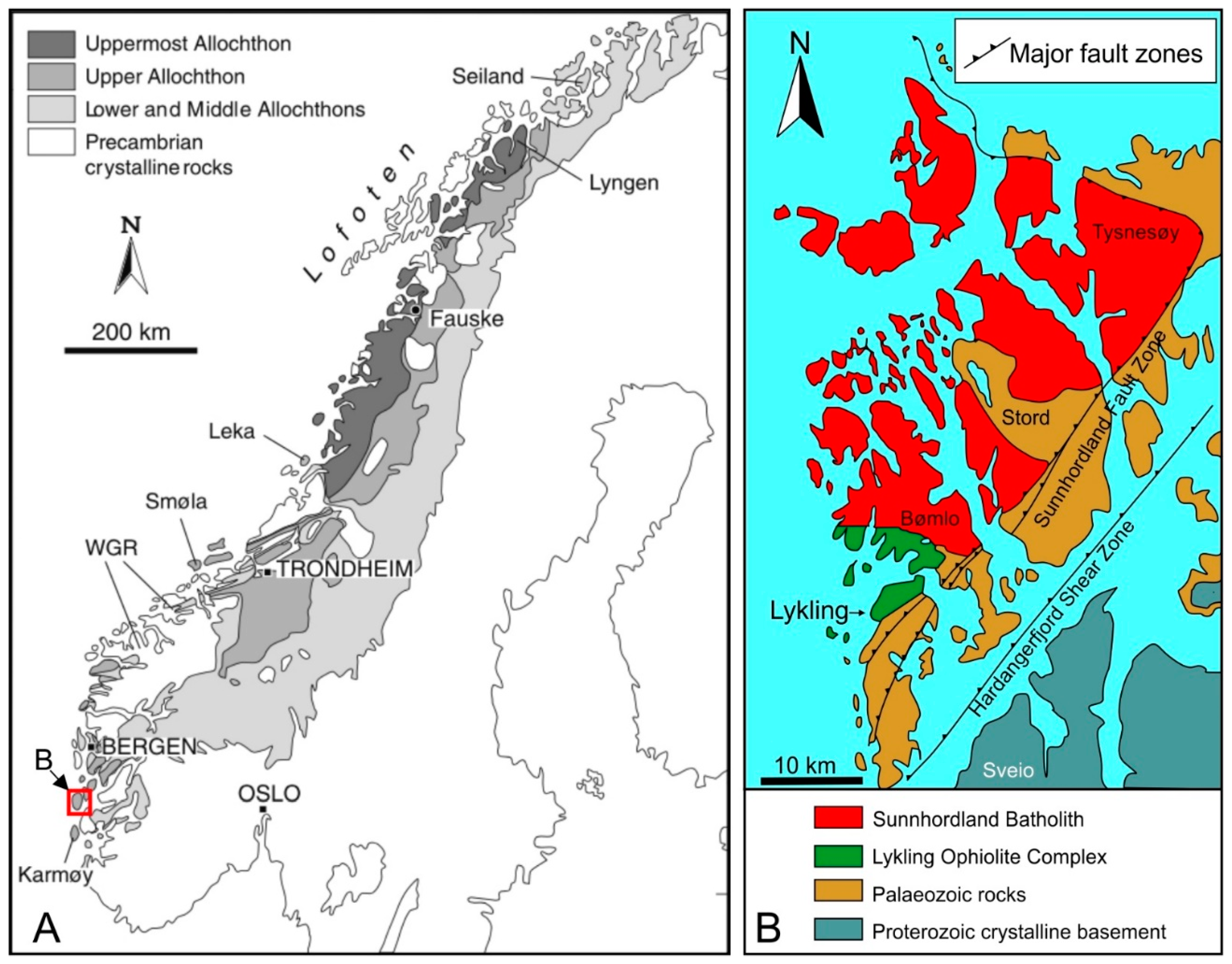

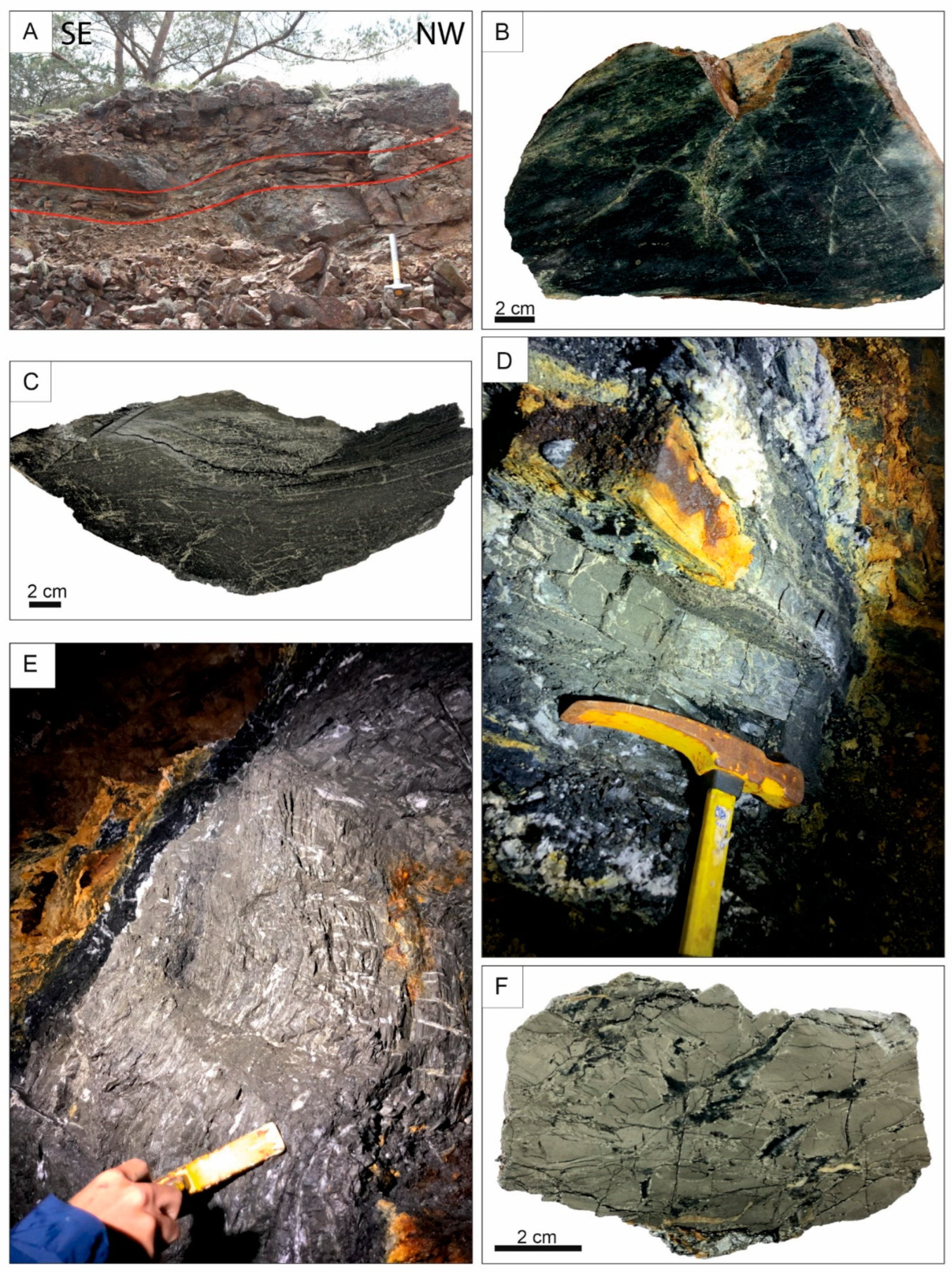

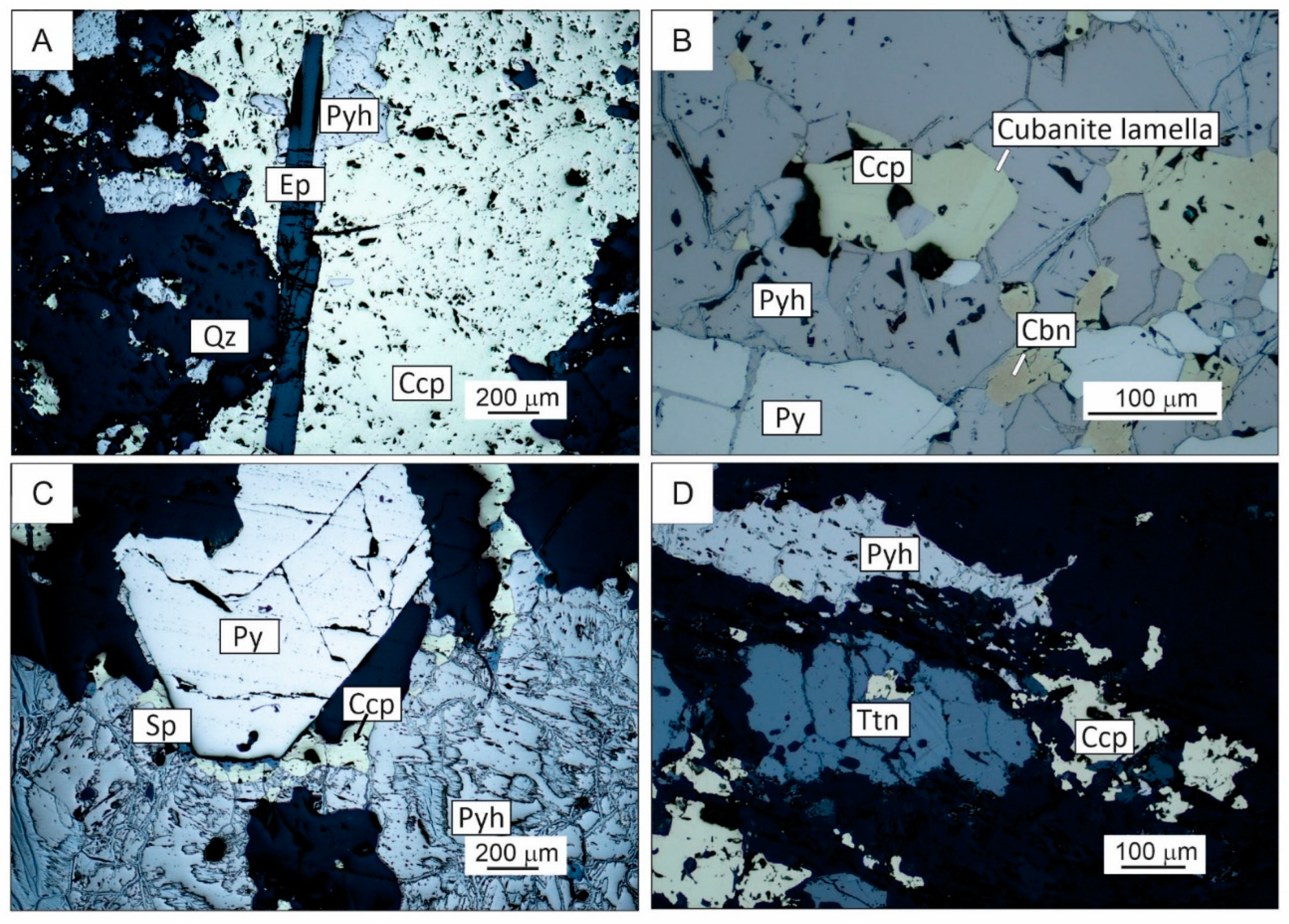
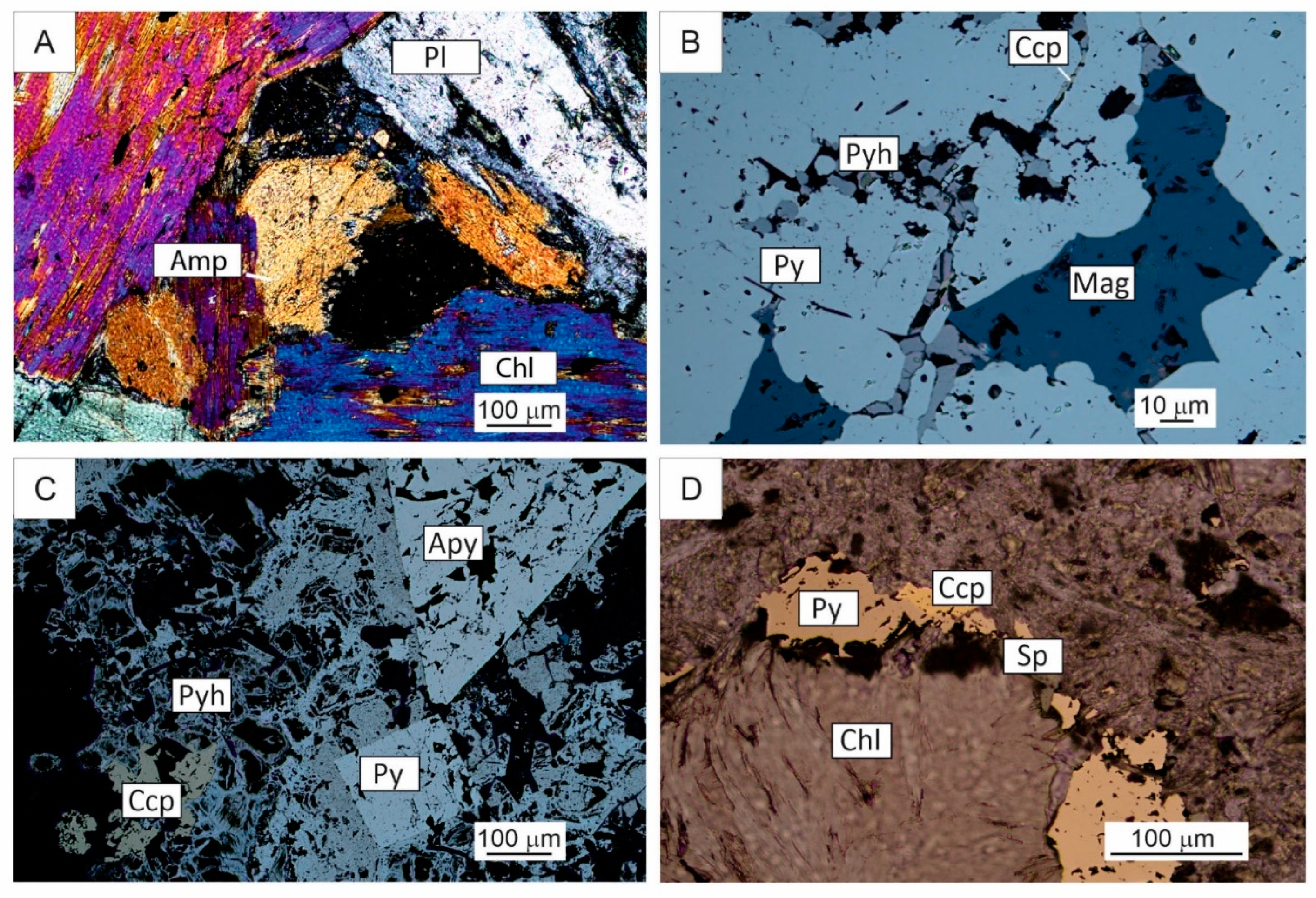
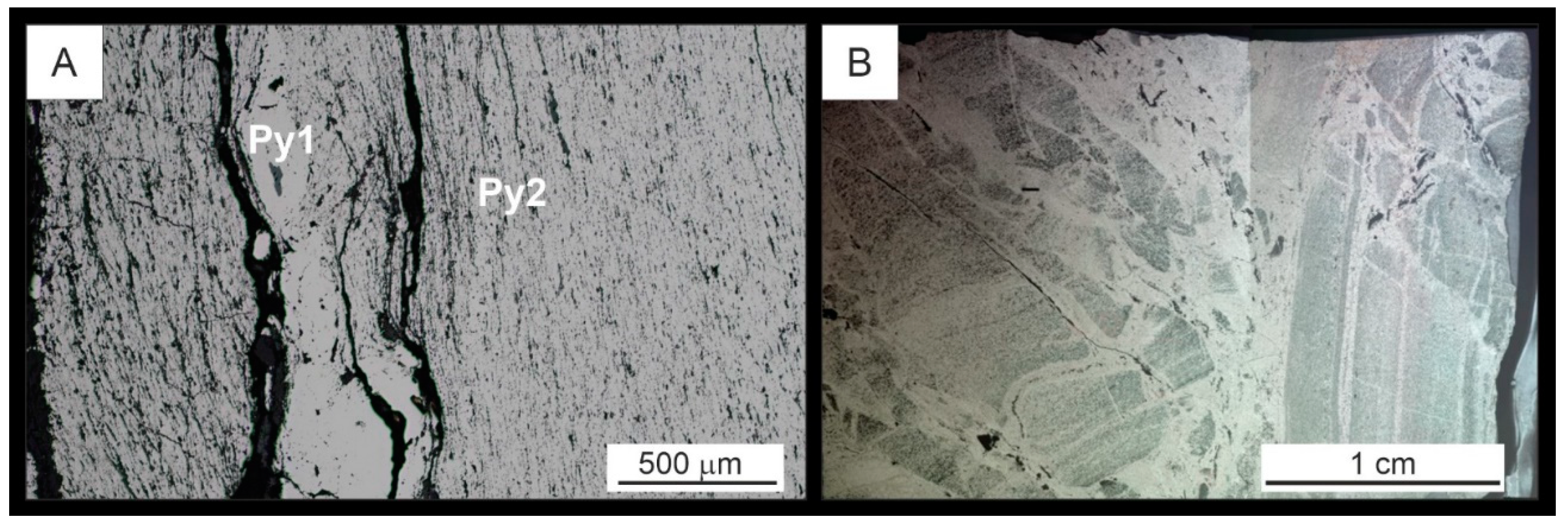
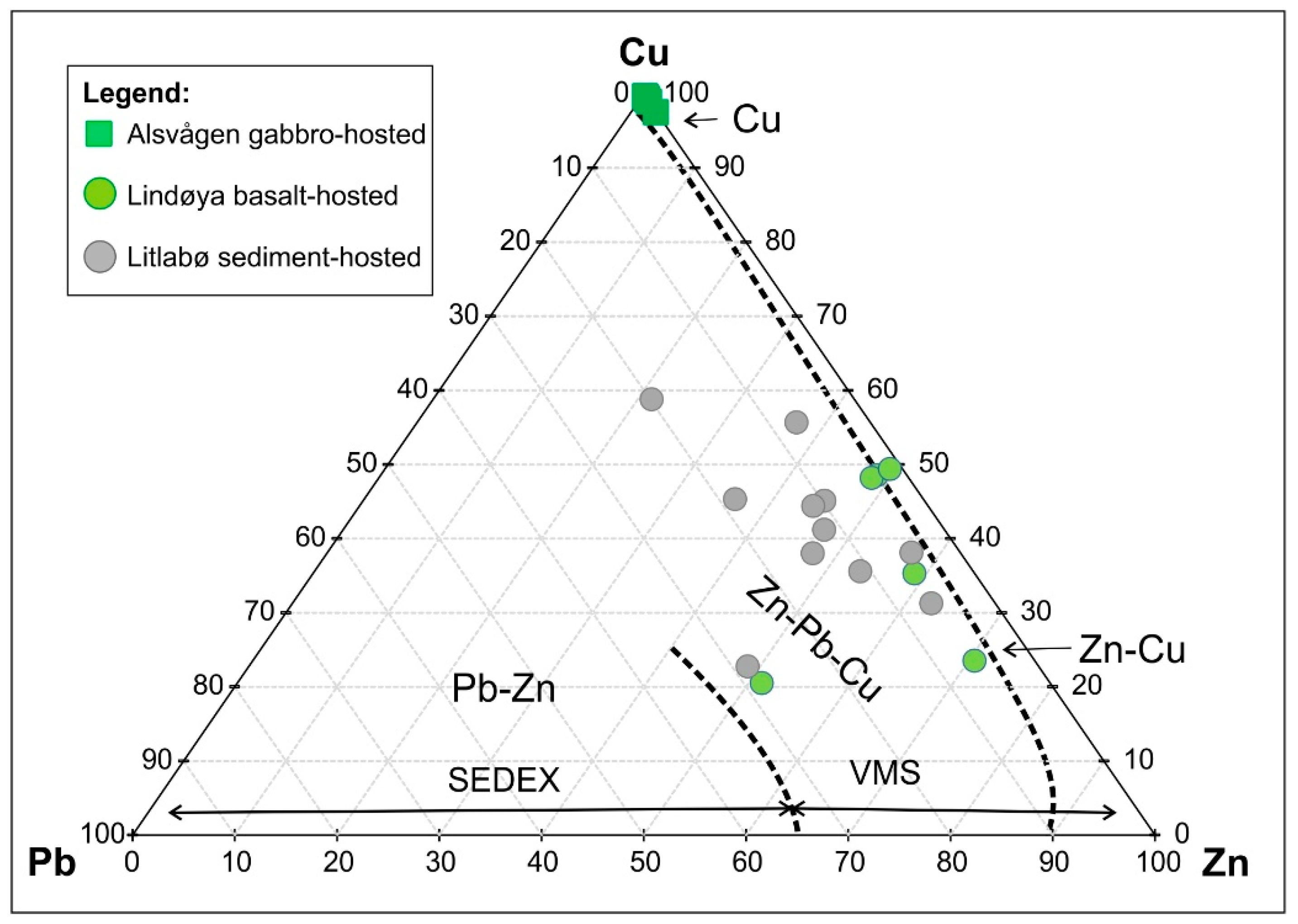
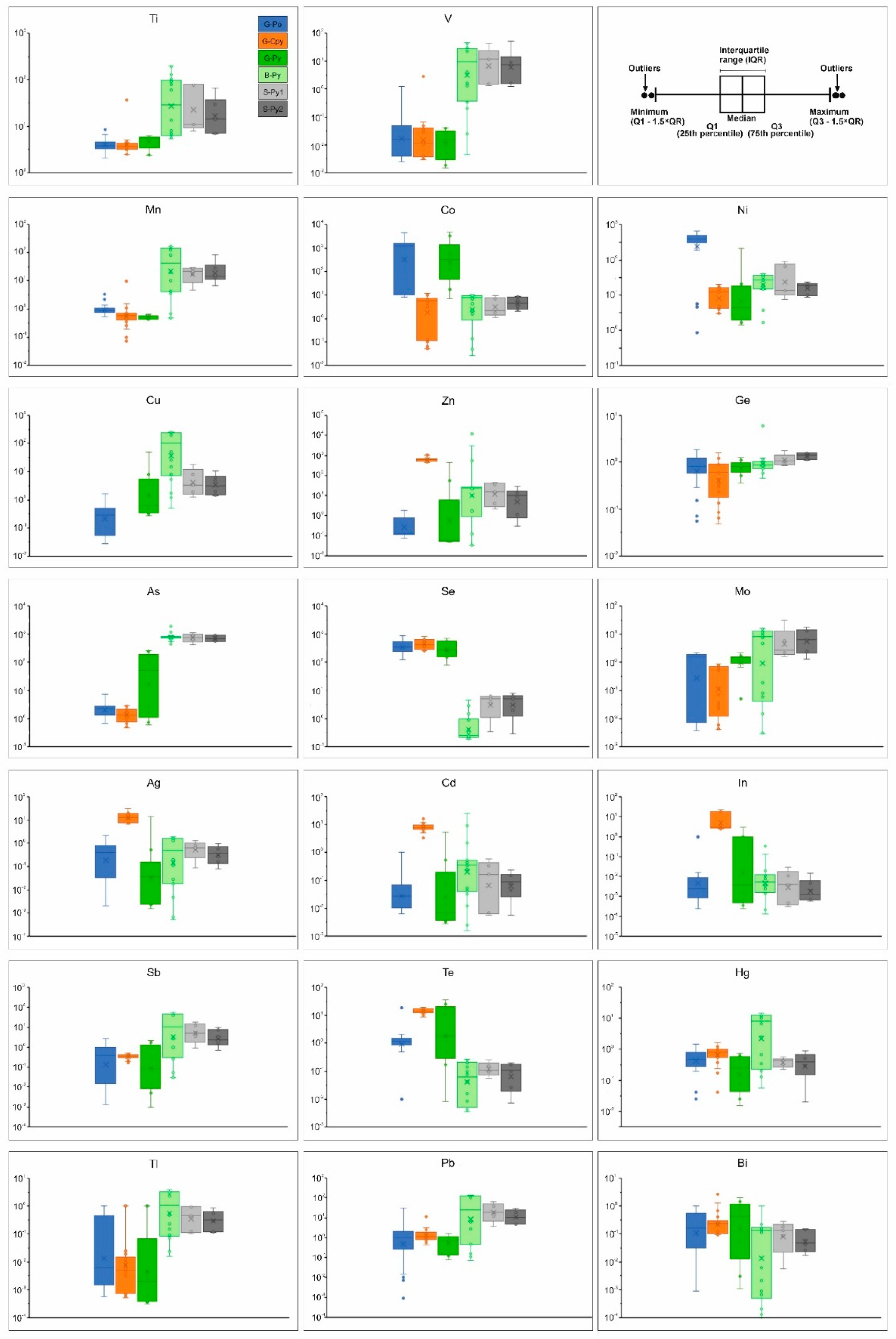
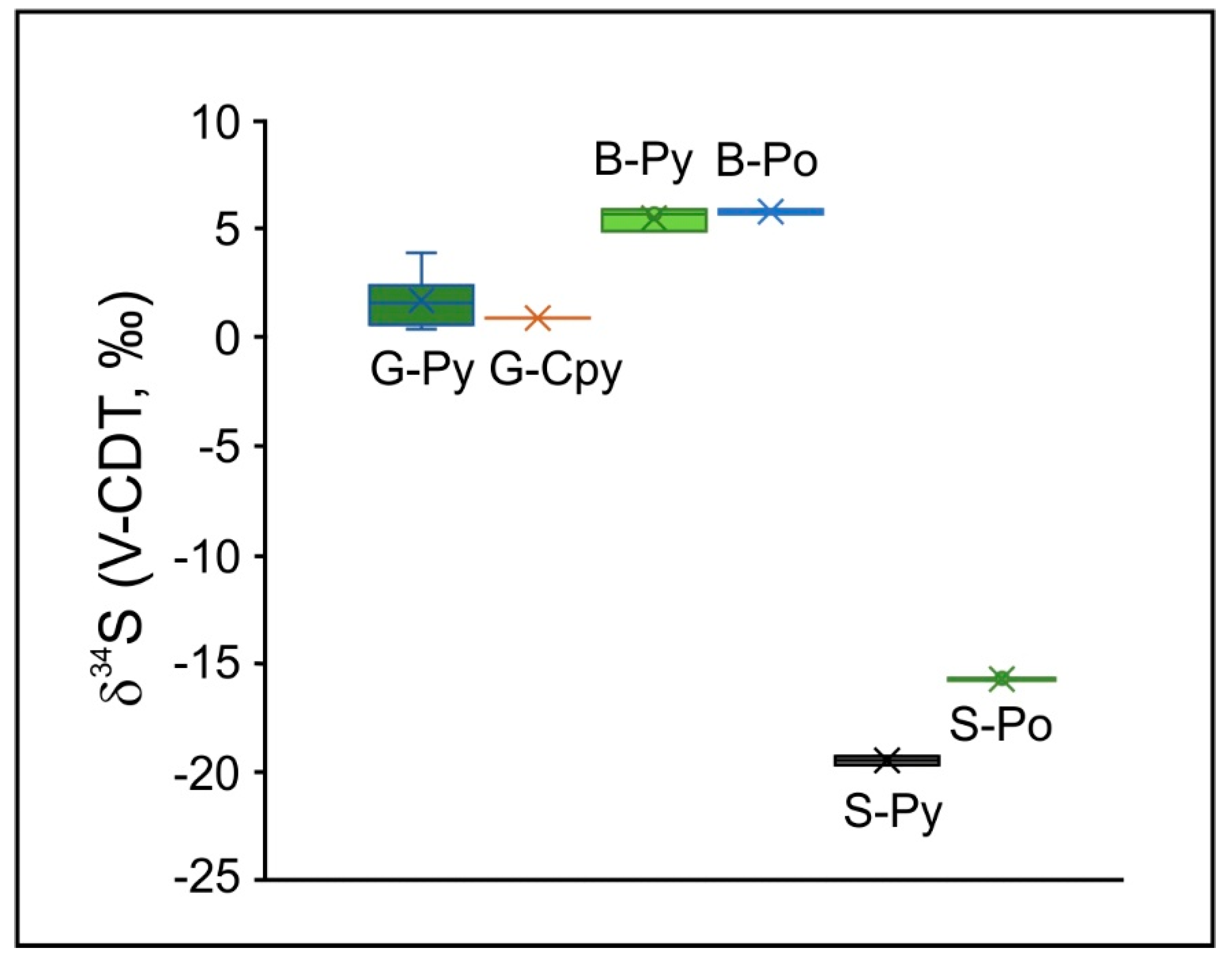
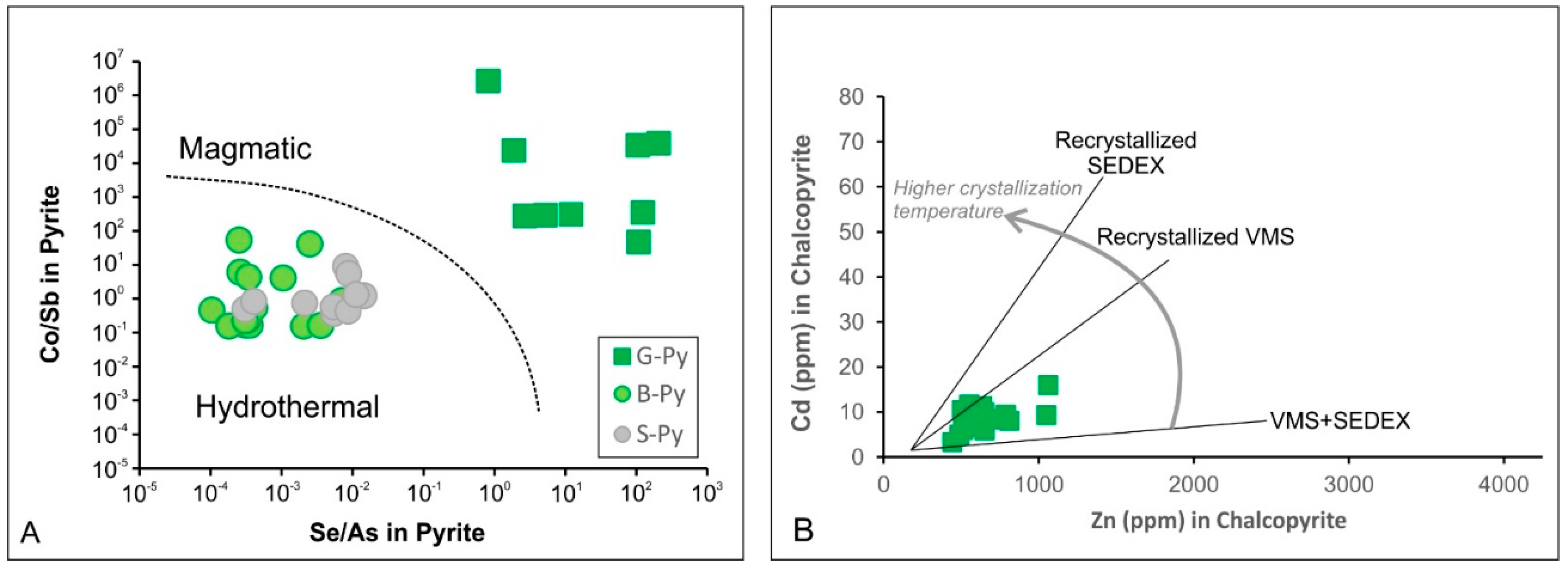


| Method | FA330 | MA370 | MA370 | MA370 | MA370 | MA370 | MA370 | MA370 | MA370 | MA370 | MA370 | MA370 | MA370 | MA370 | MA370 | MA370 | MA370 | MA370 | MA370 | MA370 | MA370 | MA370 | MA370 | MA370 | |
|---|---|---|---|---|---|---|---|---|---|---|---|---|---|---|---|---|---|---|---|---|---|---|---|---|---|
| Element | Au | Ag | Mo | Cu | Pb | Zn | Ni | Co | Mn | Fe | As | Sr | Cd | Sb | Bi | Ca | P | Cr | Mg | Al | Na | K | W | S | |
| Unit | ppb | ppm | wt.% | ||||||||||||||||||||||
| Sample | d.l. * | 2 | 2 | 0.001 | 0.001 | 0.02 | 0.01 | 0.001 | 0.001 | 0.01 | 0.01 | 0.02 | 0.01 | 0.001 | 0.01 | 0.01 | 0.01 | 0.01 | 0.001 | 0.01 | 0.01 | 0.01 | 0.01 | 0.01 | 0.05 |
| The Alsvågen gabbro-hosted VMS deposit | |||||||||||||||||||||||||
| 20ALS7S1 | 40 | 3 | <0.001 | 3339 | <0.02 | 0.01 | <0.001 | 0.004 | 0.09 | 9.04 | <0.02 | 0.02 | <0.001 | <0.01 | <0.01 | 2.18 | 0.18 | <0.001 | 1.55 | 8.50 | 4.39 | 0.21 | <0.01 | 2.90 | |
| 20ALS7S3 | 85 | 12 | <0.001 | >10.000 | <0.02 | 0.04 | 0.006 | 0.029 | 0.02 | 15.02 | <0.02 | <0.01 | <0.001 | <0.01 | <0.01 | 1.00 | 0.04 | <0.001 | 0.90 | 1.58 | 0.17 | 0.03 | <0.01 | 10.18 | |
| 20ALS6D1 | 70 | 5 | <0.001 | 5427 | <0.02 | 0.03 | 0.010 | 0.036 | 0.04 | 19.47 | <0.02 | <0.01 | <0.001 | <0.01 | <0.01 | 0.71 | 0.01 | 0.001 | 1.37 | 2.13 | 0.69 | 0.02 | <0.01 | 7.86 | |
| 20ALS3S1 | 45 | 3 | <0.001 | 1196 | <0.02 | 0.03 | 0.005 | 0.011 | 0.02 | 9.63 | <0.02 | <0.01 | <0.001 | <0.01 | <0.01 | 0.13 | <0.01 | 0.012 | 0.38 | 0.57 | 0.11 | 0.02 | <0.01 | 5.76 | |
| The Lindøya basalt-hosted VMS deposit | |||||||||||||||||||||||||
| 20LIND4B | 67 | <2 | 0.004 | 0.008 | <0.02 | 0.02 | 0.003 | <0.001 | 0.03 | 30.61 | 0.03 | <0.01 | <0.001 | <0.01 | <0.01 | 0.16 | <0.01 | 0.001 | 0.60 | 1.14 | 0.13 | 0.30 | <0.01 | >30.00 | |
| 20LINDH | 14 | <2 | <0.001 | 0.006 | <0.02 | 0.01 | 0.001 | <0.001 | 0.09 | 7.28 | <0.02 | <0.01 | <0.001 | <0.01 | <0.01 | 0.96 | 0.07 | <0.001 | 3.04 | 9.12 | 4.83 | 0.11 | <0.01 | 4.19 | |
| The Litlabø sediment-hosted VMS deposit | |||||||||||||||||||||||||
| 19LIT3 | 201 | <2 | 0.002 | 0.056 | 0.07 | 0.12 | 0.021 | 0.005 | 0.15 | 51.84 | 0.04 | <0.01 | <0.001 | <0.01 | <0.01 | 0.15 | 0.07 | <0.001 | 0.17 | 0.36 | 0.03 | 0.12 | <0.01 | 24.87 | |
| 19LIT2 | 39 | 2 | <0.001 | 0.035 | <0.02 | 0.04 | 0.006 | <0.001 | 0.07 | 38.40 | 0.05 | <0.01 | <0.001 | <0.01 | <0.01 | 0.70 | <0.01 | <0.001 | 0.17 | 0.69 | <0.01 | 0.23 | <0.01 | >30.00 | |
| Sample | Element | Cu | Zn | Fe | Mn | S | Pb | Mo | As | Ni | Se | Tl | Ag | Au |
|---|---|---|---|---|---|---|---|---|---|---|---|---|---|---|
| Unit | wt.% | ppm | ppb | |||||||||||
| The Alsvågen gabbro-hosted VMS deposit | ||||||||||||||
| Alsvåg 01 | 3.77 | 0.04 | 20.10 | 8.52 | 2 | 7.72 | 3 | 74 | 118 | <d.l. ** | 3.3 | 35 | ||
| Alsvåg 02 | 2.94 | 0.02 | 11.56 | 3.57 | 4 | 4.00 | 3 | 13 | 45 | <d.l. | 2.6 | 46 | ||
| The Lindøya basalt-hosted VMS deposit | ||||||||||||||
| Lindøya 01 | 0.02 | 0.02 | 39.5 | - | 12 | 41.3 | 233 | 76 | 16 | 1 | 0.5 | 9 | ||
| Lindøya 02 | 0.02 | 0.02 | 31.8 | - | 15 | 26.3 | 42 | 52 | 6 | <d.l. | 0.5 | 16 | ||
| Lindøya 03 | 0.02 | 0.02 | 33.9 | - | 5 | 43.5 | 12 | 60 | 13 | 2 | 0.5 | 4 | ||
| Lindøya 04 | 0.01 | 0.03 | 30.9 | - | 24 | 30.6 | 506 | 35 | 9 | <d.l. | 0.5 | 25 | ||
| The Litlabø sediment-hosted VMS deposit | ||||||||||||||
| HO0065.01 | 0.11 | 0.04 | 47.83 | 0.24 | 34.14 | 371 | 22 | 1412 | 341 | - | - | 0.8 | 284 | |
| HO0065.02 | 0.05 | 0.04 | 31.18 | 0.88 | 34.39 | 203 | 9 | 1027 | 142 | - | - | 1.2 | 160 | |
| HO0065.03 | 0.06 | 0.04 | 33.03 | 0.77 | 27.63 | 78 | 13 | 470 | 103 | - | - | 0.3 | 27 | |
| HO0065.04 | 0.02 | 0.04 | 27.73 | 0.61 | 35.21 | 40 | 5 | 571 | 74 | - | - | 0.3 | 22 | |
| HO0065.05 | 0.02 | 0.03 | 24.71 | 1.76 | 11.19 | 25 | 10 | 430 | 41 | - | - | 1.4 | 7 | |
| HO0065.06 | 0.06 | 0.06 | 47.11 | 0.08 | 33.72 | 130 | 24 | 729 | 129 | - | - | <d.l. | 25 | |
| HO0065.07 | 0.02 | 0.03 | 27.83 | 0.10 | 40.75 | 62 | 4 | 684 | 81 | - | - | 0.4 | 26 | |
| HO0065.08 | 0.04 | 0.05 | 44.11 | 0.08 | 34.70 | 152 | 18 | 744 | 130 | - | - | <d.l. | 39 | |
| HO0065.09 | 0.03 | 0.03 | 26.39 | 0.40 | 33.89 | 76 | 9 | 843 | 110 | - | - | 0.3 | 32 | |
| Sample | Mineralogy | δ34S (VCDT, ‰) |
|---|---|---|
| The Alsvågen gabbro-hosted VMS deposit | ||
| 20ALS3S1 | Pyrite | 0.5 |
| 20ALS3S2-po1 | Pyrite | 3.9 |
| 20ALS3S2-po2 | Pyrite | 0.4 |
| 20ALS4E | Pyrite | 1.8 |
| 20ALS4F | Pyrite | 3.0 |
| 20ALS7S1-po2 | Pyrite | 2.4 |
| 20ALS7S3-po1 | Pyrite | 1.4 |
| 20ALS7S3-po2 | Pyrite | 1.6 |
| 20ALS6D1-po1 | Pyrite | 1.5 |
| 20ALS6D1-po2 | Pyrite | 0.6 |
| 20ALS6D2 | Pyrite | 1.8 |
| 20ALS10B | Chalcopyrite | 0.9 |
| The Lindøya basalt-hosted VMS deposit | ||
| 20LIND-H | Pyrite | 4.9 |
| 20LIND4B-po1 | Pyrite | 5.9 |
| 20LIND4B-po2 | Pyrite | 5.7 |
| 20LIND4B-po3 | Pyrrhotite | 5.9 |
| 20LIND4B-po4 | Pyrrhotite | 5.7 |
| The Litlabø sediment-hosted VMS deposit | ||
| 19LIT2-po1 | Pyrite | −19.3 |
| 19LIT2-po2 | Pyrite | −19.7 |
| 19LIT3-po1 | Pyrrhotite | −15.8 |
| 19LIT3-po2 | Pyrrhotite | −15.7 |
| 19LIT3-po2 | Pyrrhotite | −15.7 |
Disclaimer/Publisher’s Note: The statements, opinions and data contained in all publications are solely those of the individual author(s) and contributor(s) and not of MDPI and/or the editor(s). MDPI and/or the editor(s) disclaim responsibility for any injury to people or property resulting from any ideas, methods, instructions or products referred to in the content. |
© 2024 by the authors. Licensee MDPI, Basel, Switzerland. This article is an open access article distributed under the terms and conditions of the Creative Commons Attribution (CC BY) license (https://creativecommons.org/licenses/by/4.0/).
Share and Cite
Strmic Palinkas, S.; Fjellet, T.; Stubseid, H.H.; Liu, X.; Spangenberg, J.E.; Čobić, A.; Pedersen, R.B. Trace Element and Sulfur Isotope Signatures of Volcanogenic Massive Sulfide (VMS) Mineralization: A Case Study from the Sunnhordland Area in SW Norway. Minerals 2024, 14, 384. https://doi.org/10.3390/min14040384
Strmic Palinkas S, Fjellet T, Stubseid HH, Liu X, Spangenberg JE, Čobić A, Pedersen RB. Trace Element and Sulfur Isotope Signatures of Volcanogenic Massive Sulfide (VMS) Mineralization: A Case Study from the Sunnhordland Area in SW Norway. Minerals. 2024; 14(4):384. https://doi.org/10.3390/min14040384
Chicago/Turabian StyleStrmic Palinkas, Sabina, Trond Fjellet, Håvard Hallås Stubseid, Xuan Liu, Jorge Enrique Spangenberg, Andrea Čobić, and Rolf Birger Pedersen. 2024. "Trace Element and Sulfur Isotope Signatures of Volcanogenic Massive Sulfide (VMS) Mineralization: A Case Study from the Sunnhordland Area in SW Norway" Minerals 14, no. 4: 384. https://doi.org/10.3390/min14040384
APA StyleStrmic Palinkas, S., Fjellet, T., Stubseid, H. H., Liu, X., Spangenberg, J. E., Čobić, A., & Pedersen, R. B. (2024). Trace Element and Sulfur Isotope Signatures of Volcanogenic Massive Sulfide (VMS) Mineralization: A Case Study from the Sunnhordland Area in SW Norway. Minerals, 14(4), 384. https://doi.org/10.3390/min14040384







